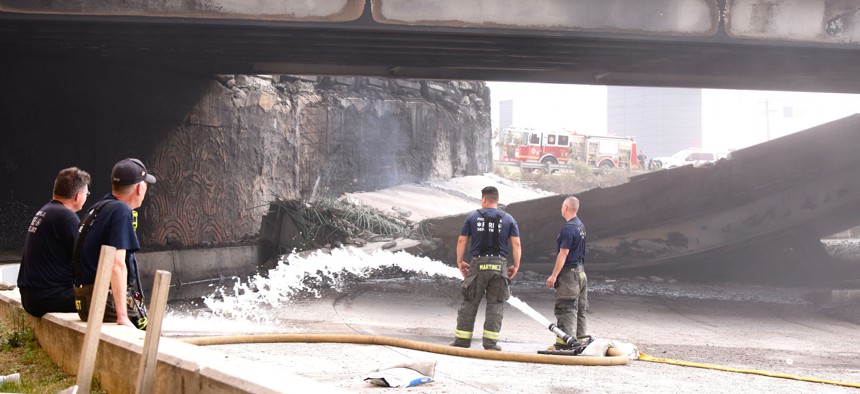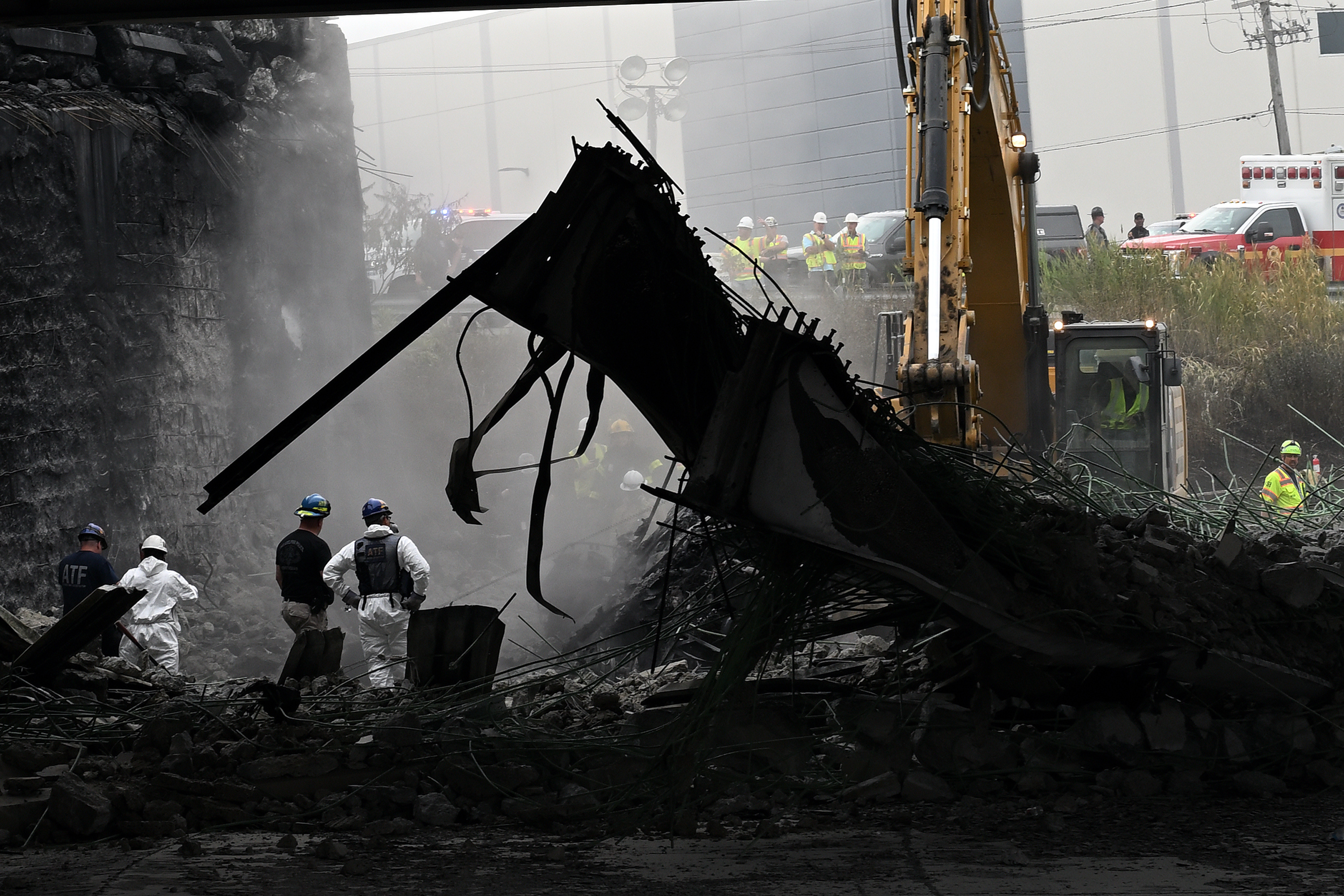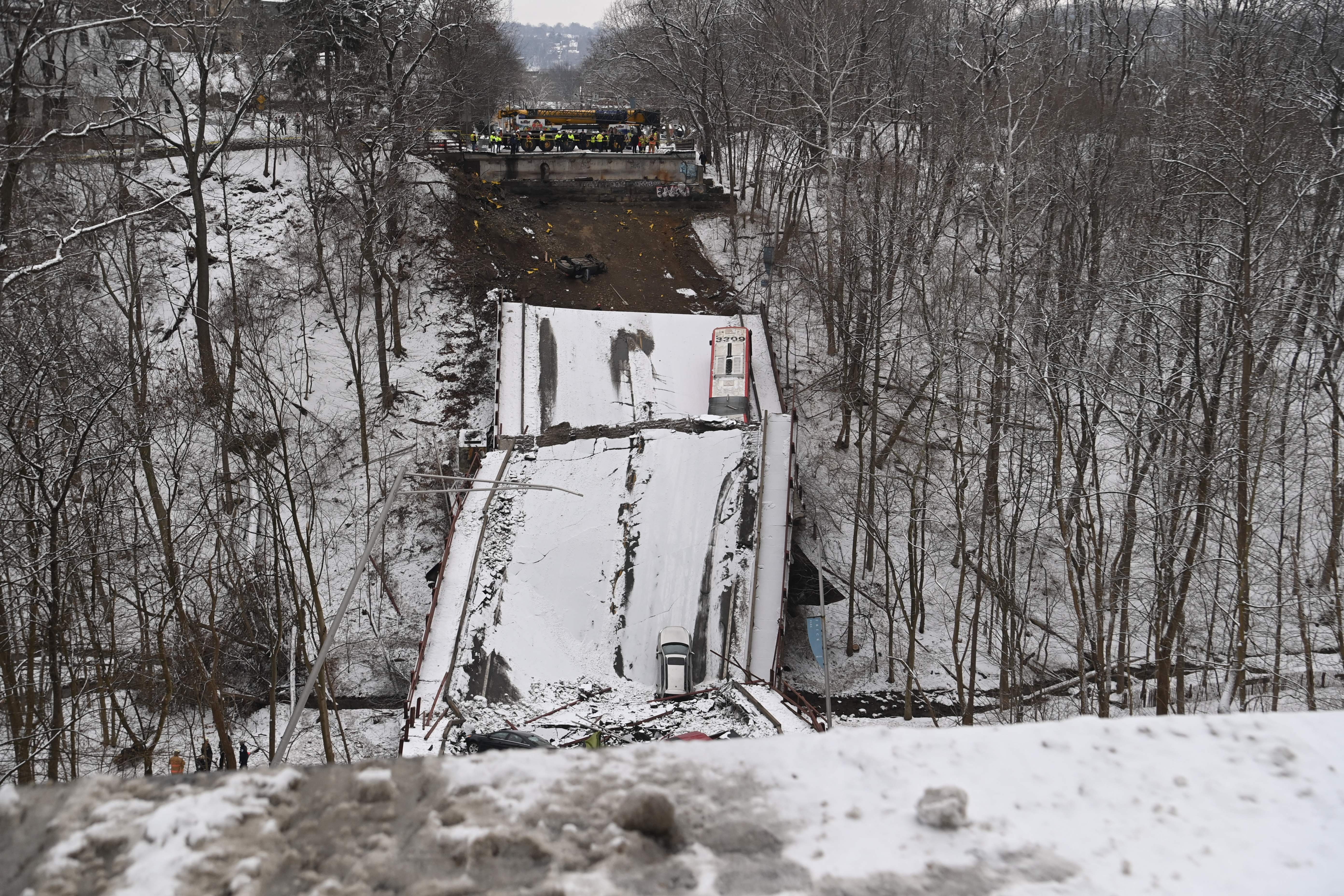Infrastructure
Federal dollars, forward progress: How transportation and transit projects are picking up speed
Pennsylvania leaders are preparing to take full advantage of a once-in-a-generation infrastructure investment.

Firefighters work at a collapsed portion of Interstate 95, caused by a large vehicle fire, in Philadelphia, Pennsylvania on June 11, 2023. Kena Betancur/Getty Images
Whether you’ve been bounced along cratered roads and highways, waited too long for a bus to get you to your destination or nervously navigated a dilapidated bridge, the same question has run through your mind: When is this ride going to get better?
Now, with the federal Infrastructure Investment and Jobs Act set to disburse billions of dollars for transportation and infrastructure spending, lawmakers and residents alike are gearing up for the opportunity to literally remake how we get around the commonwealth.
“This federal investment couldn’t come soon enough or at a better time,” Lily Reynolds, the City of Philadelphia’s inaugural director of federal infrastructure strategy, told City & State. “We are thrilled to be able to advance and build a lot of the projects that we have had in the queue for many years.”
The influx in federal funding is a sight for sore eyes in the Keystone State, which was given a C- grade in the American Society of Civil Engineers’ 2022 infrastructure report. Over the next five years, the state is expected to receive $11.3 billion for federal-aid highway apportioned programs, $1.6 billion for bridge replacement and repairs, $2.8 billion to improve public transportation and $1.4 billion to improve water infrastructure, among many other large infrastructure investments.
Alongside the long-awaited infusion of federal funds comes a golden opportunity to lay the groundwork for a more diverse labor force in the commonwealth. The federal law also comes with a workforce development mandate, with more than $800 million being made available nationally to provide workers in underserved communities opportunities to upskill or train and gain access to unionized jobs in the construction sector.
“This is an opportunity to really grow our partnerships and to have win-win situations between the city, the community and organized labor,” Reynolds said. “With a lot of these projects, because of how long capital investment takes, we will still see the economic impact, workforce impact and business impact in our region for years following that.”
That focus on expanded opportunities extends to the state level as well. “When it comes to providing contracting opportunities, the Shapiro administration recognizes that small and diverse businesses are central to our communities and our economy,” Pennsylvania Department of Transportation spokesperson Alexis Campbell told City & State. “PennDOT typically spends more than $2 billion annually in construction contracts and $500 million in consultant contracts, and we are now entering a time where even more dollars will be invested in infrastructure. We must ensure that as the tide rises in the transportation sector, that small and diverse businesses prosper and grow. We’ve taken a hard look at our processes to determine whether there are unnecessary barriers when doing work for PennDOT that prevent disadvantaged business enterprises, specifically Black-owned businesses, from submitting proposals.”
Falling through the cracks
Rough roads are nothing new for drivers who have had to deal with decreased funding and aging infrastructure in a state that experiences all kinds of weather extremes, which have contributed to Pennsylvania’s infamous potholes and broken bridges.
“The challenge in Pennsylvania is to modernize its transportation system at a time when it’s suffering from significant aging and heavy use,” Rocky Moretti, director of policy and research at TRIP, a national transportation research nonprofit, told City & State. “You have a significantly aging system and Pennsylvania, in terms of climate, has the full gamut of freeze-thaw cycles that put stress on their systems.”
According to the Federal Highway Administration, Pennsylvania is one of just 11 states with a roadway network of more than 250,000 miles. Moretti noted that 28% of major roads in the commonwealth, including highways, have pavements in poor condition, and another 23% of roads are rated as being in mediocre condition. Those state routes also include roughly 25,000 bridges, many of which have been considered structurally deficient for some time.
“Infrastructure makes or breaks communities,” state Rep. Ed Neilson told City & State. Neilson, chair of the House Transportation Committee, noted that the average age of the state’s bridges is more than 50 years. If one bridge or roadway were to collapse – an occurrence the commonwealth has endured recently with the Fern Hollow Bridge in Pittsburgh and the I-95 overpass in Philadelphia – an important artery to a community could be lost.
“If you put in a (turnpike) exit ramp, that could make a whole city. Without it, it breaks it,” Neilson said. “There are little towns that can become big towns if you have the infrastructure and a ramp to give easy access to the highways.”
Comprehensive infrastructure and its subsequent impact on the surrounding community is nowhere more apparent than in public transportation. Leslie Richards, general manager of the Southeastern Pennsylvania Transportation Authority – better known as SEPTA – said the concept of equity is front-and-center in everything they do. And for an entity with a backlog of more than $5 billion in system projects, federal funding is seen as a lifeline.
“We just have never had the money because of how we are funded. We are the lowest-funded large legacy system in the country,” Richards told City & State. “SEPTA got the largest grant we have ever received – at least in our recent history – an $80 million grant … It’s a significant number and it goes into some of our most disadvantaged neighborhoods.”
Richards described SEPTA as an “instrumental fabric” of the City of Philadelphia and the collar counties that it serves. As the agency focuses on projects in four primary areas – trolley modernization, new-vehicle procurement, development of a zero-emission bus fleet and improvements to meet Americans with Disabilities Act accessibility guidelines – Richards understands the impacts that mobility provides to a given community.
“Every time we improve reliability, every time we improve frequency and every time we improve quality of service, we are improving those neighborhoods,” she said. “We are often reminded that we are the poorest large city in the entire country. We need to do as much as we can to get people out of poverty and give people opportunities. That’s truly what transit is about – giving people opportunities.”

Planes, trains and automobiles
The opportunities on the horizon for SEPTA are plentiful. The federal funding includes a $25 million investment in upgrading existing platforms, stations and trolleys and another $56 million to put in elevators, escalators and other features needed to ensure every station is ADA-compliant. When the 12-year accessibility program is completed, Richards said, it will be the first time in Philadelphia that every subway station meets ADA standards.
But within the accessibility conversation, that’s not all. IIJA funding covers everything infrastructure-related, from electric vehicle chargers and pedestrian safety to airports and waterways. On top of the massive investments drivers and pedestrians are anxiously awaiting, significant funding streams are also in place to modernize how people and information get around, both on the road and online.
Pennsylvania is slated to receive $171 million to support electric vehicle charging network expansion, $26 million to protect against cyberattacks and a highly anticipated $1.16 billion to expand broadband coverage across the state.
When asked to describe the importance of the IIJA funds, Pennsylvania Department of Transportation Secretary Mike Carroll used one word: critical.
“It matters a lot,” Carroll told City & State, referring to the projects that would have been pushed back without the major federal investment. “It’s sort of like jets on the taxiway. With the additional federal money, we can set some (projects) out and on their way.”
The connectivity of a community, and the economic mobility of its residents, hinges on its access to public transit and modern commodities like internet service. Reynolds said that as Philadelphia prioritizes projects, particularly the placement, design and contracting of the construction, officials are ensuring historically disenfranchised communities aren’t left out yet again.
“There is a clear recognition, certainly from community members, but now also from all levels of government, that infrastructure and government investment have, in some cases, been harmful and destructive to communities, especially low-income communities,” Reynolds said. “It’s critical that we are focusing on how these communities are not paved over, they’re not washed away and they’re not ignored in the planning process.”
The future workforce
With the approaching distribution of funds and the ambitious list of proposed projects, another question comes to the surface: Who will do these projects?
The growing queue of infrastructure projects will ultimately become the responsibility of organized labor and other contractors in the City of Philadelphia and across the commonwealth. The equity conversation also comes into play as project planning, workforce development and bidding processes.
“In many ways, every single project that transit has and that SEPTA has is providing for a more equitable future,” Richards told City & State. “We’re using the money that’s coming out of the federal infrastructure bill so that we’re not only building and creating better infrastructure for everyone, but we are also providing jobs and opportunities for those who haven’t had them before.”
Not only are officials calling for projects to connect marginalized communities to adequate infrastructure, but they also are seeking to develop a diverse workforce through these projects and using discretionary federal funds to expand existing union pre-apprenticeship and training programs. For Reynolds, the first person to hold the role of Director of Federal Infrastructure Strategy for the city’s Office of Transportation, Infrastructure and Sustainability, this opportunity is a long time coming.
“This is an exciting moment,” she said, “because our mandate and approach to the bipartisan infrastructure law is to do more than build roads, bridges, water systems, airports, rails, broadband, electric vehicle, but also all of the things that really make sure that we are investing in Philadelphians and that we’re growing generational wealth in communities of color in particular.”
Both in Philadelphia and at the state level, calls to rethink workforce development have come up time and again. The state’s aging population, not just its aging infrastructure, is a major contributor to this push. IIJA specifically allows states to expend funds from surface transportation programs, such as road and bridge repairs, and use them on key workforce development activities and long-term planning.

“The IIJA is an unprecedented investment … Our union partners are working with PennDOT and the contracting industry to support equitable workforce development through efforts like on-the-job training to encourage participation in various apprenticeship projects,” Campbell said. “The industry also works with us in ensuring the OJT opportunity allows more participation in the skilled trades – like carpentry, masonry, operating engineers – that have historically been not as involved due to difficulty in obtaining the required 1,000 hours per project per year. We also are looking to partner with the unions and industry on future recruitment efforts, especially in the underrepresented and marginalized areas to introduce transportation as a career opportunity, not just a job.”
Equity will be prioritized in two components, Reynolds said. First, in developing workforce development opportunities, Philadelphia is seeking to connect a diverse population of residents to job preparation and training, whether that be in the planning process related to design and project management or in construction itself and having qualified boots on the ground.
“There’s more work to be done in terms of raising awareness and also making sure that we have programs that are diverse and equitable and that are feeding into the unions,” she said.
The second focal point is the business-to-business communications and having all regional partners on the same page regarding outreach and assistance to minority-owned businesses and women-owned businesses.
“We have such a big demand and I think we have great leadership, both within all levels of government but also with our labor partners,” Reynolds said. “Now (is the time) to really capitalize on this moment.”
